Badis
←Back
Chameleon Badis
(Badis Badis)

Difficulty: 2/5
Tank minimum: 20 gallon
Water parameters: 73-79° F, KH 10-15, pH 6.5-7.5
Maximum size: 2.5″
Tank region: Bottom/mid-dwelling, will perch on decorations
Behavior: Peaceful, males will display to one another
Diet: Picky, Carnivore, may only eat live and/or frozen food such as tubifex worms, blackworms, daphnia, and crustaceons. Can possibly get onto a high quality flake or small pellet.
Compatibility: Other similar sized, peaceful fish.
Extra: These are fairly hardy fish to keep as long as you keep their water clean and accommodate their picky nature. Due to this pickiness with food, I have given them a score of 2/5. Choose tankmates wisely as fish that are aggressive eaters may make it difficult to feed the badis. A tank with lots of cover and hiding spots, preferably with live plants is an ideal environment for this fish.
Back to the top
Scarlet Badis
(Dario Dario)
Difficulty: 2/5
Tank minimum: 10 gallon
Water parameters: 73-79° F, KH 10-15, pH 6.5-7.5
Maximum size: 1″
Tank region: Bottom/mid-dwelling, will perch on decorations
Behavior: Peaceful, males will display to one another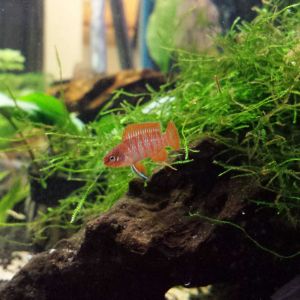
Diet: Picky, Carnivore, may only eat live and/or frozen food such as tubifex worms, blackworms, daphnia, and crustaceons. Can possibly get onto a high quality flake or small pellet.
Compatibility: Other similar sized, peaceful fish.
Extra: These badis stay much smaller than it’s relative, the badis badis, making them a suitable candidate for Nanotanks. Some do enjoy the company of their own species, but can still be territorial so it’s important that there are plenty of hiding spots (preferably with live plants) and multiple territories, particularly if you keep more than one. These are fairly hardy fish to keep as long as you keep their water clean and accommodate their picky nature. Due to this pickiness with food, I have given them a score of 2/5. Choose tankmates wisely as fish that are aggressive eaters may make it difficult to feed the badis.
Bumblebee goby
Bumblebee Goby
(Brachygobius xanthozona)
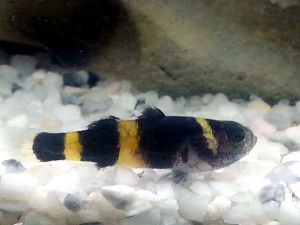

Difficulty: 3/5
Tank minimum: 30 gallons
Water parameters: 75-80F, Salinity 1.005-1.008, PH 7.0 – 8.0, GH 8 – 20 dH
Maximum size: 1 3/4″
Tank region: Bottom dwelling/Perching
Behavior: Peaceful community, conspecific territorial but recommended to keep with same species as they can be shy.
Diet: Live foods such as worms and brine shrimp, can be trained onto frozen. Very picky, which is increased if housed without other bumblebees.
Compatibility: Suitable for community or semi-aggressive fish that are not aggressive eaters. 4 or more of same species is ideal.
Extra: This species of bumblebee goby ideally should still be kept in brackish water. However, it is much more tolerant of freshwater than others of this species. They are ambush predators waiting for their food to comes to them, making feeding time a bit difficult. Due to this and the trickiness of finding them suitable tankmates gives them a rating of 3/5. They can be territorial with their own species, however it seldom causes any damage. In fact, this territorial display is actually what makes them very interesting to watch. They should have plenty of hiding spaces and cover.
Cory Cat
Bandit Cory Cat
Bronze Cory Cat
Emerald Cory Cat
Panda Cory Cat
Schwartzi Cory Cat
Skunk Cory Cat
Sterbai Cory Cat
←Back
Bandit Cory
(Corydoras metae)
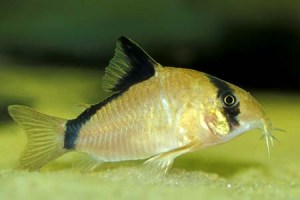
Difficulty: 1/5
Tank minimum: 20 gallon long
Water parameters: pH 6.0-8.0, 74F-82F
Maximum size: 2″
Tank region: Bottom dwelling
Behavior: Peaceful. Schooling fish that should be kept at a minimum of 3 and ideally in a group of 6 or more.
Diet: Easy, will eat a variety of fish flake, pellets, and frozen food. Recommended to supplement of sinking pellet or wafer on occasion to ensure they are getting food.
Compatibility: Wonderful addition for peaceful and semi-aggressive community
Extra: Cory cats are a perfect beginner fish and wonderful addition to almost any aquarium. This armored catfish is also very hardy and are a forgiving species. Cory cats ideally do best on a sandy substrate, but can be on any substrate as long as it doesn’t have sharp edges that could damage their barbels.
Bronze/Albino Corydoras
(Corydoras aeneus)

Difficulty: 1/5
Tank minimum: 20 gallon
Water parameters: pH 6.0-8.0, o74F-82F
Maximum size: Average size 2″ but can be seen up to 3″
Tank region: Bottom dwelling
Behavior: Peaceful. Schooling fish that should be kept at a minimum of 3 and ideally in a group of 6 or more.
Diet: Easy, will eat a variety of fish flake, pellets, and frozen food. Recommended to supplement of sinking pellet or wafer on occasion to ensure they are getting food.
Compatibility: Wonderful addition for peaceful and semi-aggressive community
Extra: The bronze cory cat also comes in a white variety that is commonly known in the trade as the albino cory cat. Cory cats are a perfect beginner fish and wonderful addition to almost any aquarium. This armored catfish is also very hardy and are a forgiving species. Cory cats ideally do best on a sandy substrate, but can be on any substrate as long as it doesn’t have sharp edges that could damage their barbels.
Emerald cory
(Brochis splendens)
Difficulty: 1/5
Tank minimum: 30 gallon long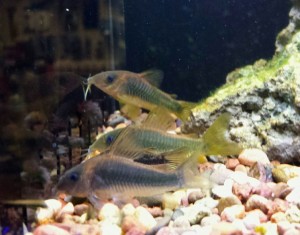
Water parameters: pH 6.0-8.0), 74F-82F
Maximum size: 3.5″
Tank region: Bottom dwelling
Behavior: Peaceful. Schooling fish that should be kept at a minimum of 3 and ideally in a group of 6 or more.
Diet: Easy, will eat a variety of fish flake, pellets, and frozen food. Recommended to supplement of sinking pellet or wafer on occasion to ensure they are getting food.
Compatibility: Wonderful addition for peaceful and semi-aggressive community
Extra: The emerald cory cat is larger than most other cory cats, and actually not a true cory cat. It is part of the family “Bronchis” instead of “Corydoras.” Cory cats are a perfect beginner fish and wonderful addition to almost any aquarium. This armored catfish is also very hardy and are a forgiving species. Cory cats ideally do best on a sandy substrate, but can be on any substrate as long as it doesn’t have sharp edges that could damage their barbels.
Panda Cory Cat
(Corydoras Panda)
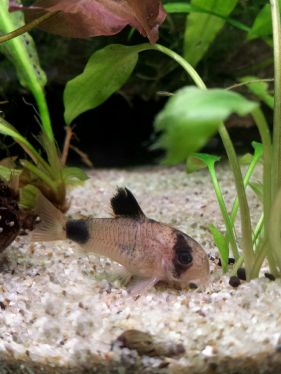
Difficulty: 1/5
Tank minimum: 20 gallon
Water parameters: pH 6.0-8.0, 74F-82F
Maximum size: 2″
Tank region: Bottom dwelling
Behavior: Peaceful. Schooling fish that should be kept at a minimum of 3 and ideally in a group of 6 or more.
Diet: Easy, will eat a variety of fish flake, pellets, and frozen food. Recommended to supplement of sinking pellet or wafer on occasion to ensure they are getting food.
Compatibility: Wonderful addition for peaceful and semi-aggressive community
Extra: Cory cats are a perfect beginner fish and wonderful addition to almost any aquarium. This armored catfish is also very hardy and are a forgiving species. Cory cats ideally do best on a sandy substrate, but can be on any substrate as long as it doesn’t have sharp edges that could damage their barbels.
Peppered Cory Cat
(Corydoras paleatus)

Difficulty: 1/5
Tank minimum: 20 gallon long
Water parameters: pH 6.0-8.0, 74F-82F
Maximum size: 3″
Tank region: Bottom dwelling
Behavior: Peaceful. Schooling fish that should be kept at a minimum of 3 and ideally in a group of 6 or more.
Diet: Easy, will eat a variety of fish flake, pellets, and frozen food. Recommended to supplement of sinking pellet or wafer on occasion to ensure they are getting food.
Compatibility: Wonderful addition for peaceful and semi-aggressive community
Extra: Cory cats are a perfect beginner fish and wonderful addition to almost any aquarium. This armored catfish is also very hardy and are a forgiving species. Cory cats ideally do best on a sandy substrate, but can be on any substrate as long as it doesn’t have sharp edges that could damage their barbels.
Schwartzi Cory
(Corydoras Schwartzi)
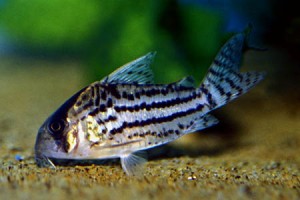
Difficulty: 1/5
Tank minimum: 20 gallon
Water parameters: pH 6.0-8.0, 74F-82F
Maximum size: 2.8″
Tank region: Bottom dwelling
Behavior: Peaceful. Schooling fish that should be kept at a minimum of 3 and ideally in a group of 6 or more.
Diet: Easy, will eat a variety of fish flake, pellets, and frozen food. Recommended to supplement of sinking pellet or wafer on occasion to ensure they are getting food.
Compatibility: Wonderful addition for peaceful and semi-aggressive community
Extra: Cory cats are a perfect beginner fish and wonderful addition to almost any aquarium. This armored catfish is also very hardy and are a forgiving species. Cory cats ideally do best on a sandy substrate, but can be on any substrate as long as it doesn’t have sharp edges that could damage their barbels.
Skunk Cory Cat
(Corydoras Arcuatus)

Difficulty: 1/5
Tank minimum: 15 gallon long
Water parameters: pH 6.0-8.0, 74F-82F
Maximum size: 2″
Tank region: Bottom dwelling
Behavior: Peaceful. Schooling fish that should be kept at a minimum of 3 and ideally in a group of 6 or more.
Diet: Easy, will eat a variety of fish flake, pellets, and frozen food. Recommended to supplement of sinking pellet or wafer on occasion to ensure they are getting food.
Compatibility: Wonderful addition for peaceful and semi-aggressive community
Extra: Cory cats are a perfect beginner fish and wonderful addition to almost any aquarium. This armored catfish is also very hardy and are a forgiving species. Cory cats ideally do best on a sandy substrate, but can be on any substrate as long as it doesn’t have sharp edges that could damage their barbels.
Sterbai Corydoras
(Corydoras Sterbai)

Difficulty: 1/5
Tank minimum: 20 gallon long
Water parameters: pH 6.0-8.0, Temperature of 74-82
Maximum size: 3″
Tank region: Bottom dwelling
Behavior: Peaceful. Schooling fish that should be kept at a minimum of 3 and ideally in a group of 6 or more.
Diet: Easy, will eat a variety of fish flake, pellets, and frozen food. Recommended to supplement of sinking pellet or wafer on occasion to ensure they are getting food.
Compatibility: Wonderful addition for peaceful and semi-aggressive community
Extra: Cory cats are a perfect beginner fish and wonderful addition to almost any aquarium. This armored catfish is also very hardy and are a forgiving species. Cory cats ideally do best on a sandy substrate, but can be on any substrate as long as it doesn’t have sharp edges that could damage their barbels.
back to the top
Danio
Celestial Danio
Giant Danio
Zebra Danio
Celestial Danio
(Celestichthys margaritatus)

Difficulty: 1/5
Tank minimum: 10 gallon
Water parameters: : 73-79° F, KH 8-12, pH 6.5-7.5
Maximum size: 1″
Tank region: Mid-dwelling
Behavior: Peaceful, schooling. Can be shy
Diet: Will accept most foods of flake and pellet, though they may not come to the surface to eat. Frozen or live foods such as daphnia and brine will help enhance their coloring.
Compatibility: Should be kept with no less than 3 of the same species and ideally in groups of 5 or more. Other similar sized, peaceful fish.
Extra: The celestial danio is beautiful addition to any microfish collection. Because of this stunning appearance, they are quickly becoming quite popular in the trade. Only recently discovered, there is still much to be learned about this wonderful little fish. What we do know is that they can be shy and do best in an aquarium that has plenty of cover and hiding, preferably with an abundant amount of live plant.
Giant Danio
(Devario aequipinnatus)
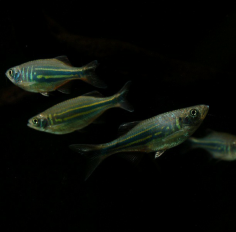
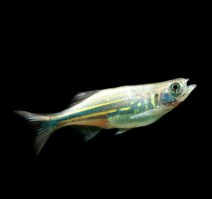
Difficulty: 1/5
Tank minimum: 30 gallons
Water parameters: 72-75° F, KH 8-12, pH 6.0-7.0
Maximum size: 4″
Tank region: Mid-upper dwelling
Behavior: Peaceful and active, schooling fish
Diet: Accepts all foods
Compatibility: Community fish not suited for fish that are slow moving, shy or timid about eating. It is also not recommended to keeping them with smaller community fish. Work excellent in cichlid tanks, as long as the cichlid aren’t too overly aggressive.
Extra: The giant danio is a great addition for larger tanks looking for an active and interesting school. They also work well as a target/dither fish for many cichlids. This schooling fish should be kept in a minimum of a group of 6 or they may start to pick on other fish, including each other. Due to their aggressive eating habits, they are not ideal tankmates for timid eaters.
Zebra Danio
(Danio rerio)

Difficulty: 1/5
Tank minimum: 10 gallon
Water parameters: 64-75° F, KH 8-12, pH 6.5-7.0
Maximum size: 2.5″
Tank region: All over, mostly top dwelling
Behavior: Active schooling fish
Diet: Will accept most foods
Compatibility: Suitable in community tanks. Fish with long, flowing fish may become a target of fin nipping.
Extra: The zebra danio is inexpensive, hardy, and readily available in the hobby making it a perfect choice for beginners. Due to it’s hardy nature, it makes a great choice for starting or cycling a tank.
Endler’s Livebearers
Poecilia sp

Difficulty: 1/5
Tank minimum: 5 gallons
Water parameters:64-82° F, KH 10-30, pH 5.5-8.0
Maximum size: 1″
Tank region: Mid-top dwelling
Behavior: Peaceful, schooling
Diet: They will accept a variety of flake or pellet.
Compatibility: Other similar sized, peaceful fish.
Extra: This cousin of the guppy is an active and undemanding fish. They do best in a tank that is heavily planted with a lot of hiding places. The males have been known to display and flare their colors at one another, but no real fights will occur.
Goldfish
Oranda Goldfish
Pearlscale Goldfish
Ranchu Goldfish
Ryukin Goldfish
Oranda Goldfish

Difficulty: 1/5
Tank minimum: 20 gallons
Water parameters: 65-75° F, KH 4-20, pH 6.5-7.5
Maximum size: 8″
Tank region: All over
Behavior: Peaceful
Diet: Food formulated specificially for goldfish, though variety is appreciated.
Compatibility: Best suited with other goldfish. Many fish cannot tolerate the amount of waste these fish produce.
Extra: Oranda Goldfish are characterized by the bubble-like growth on their head. They are a hardy and easy fish to care for making them a suitable choice for beginners. Unlike the flat-bodied types of goldfish, the Oranda has a lower tolerance for pollution and cannot tolerate temperatures much below 60° F. Because of this, it is highly recommended to have a filter, though not required. Like all goldfish, they have a high bioload and water can foul fairly quickly.
Pearlscale Goldfish

Difficulty: 1/5
Tank minimum: 20 gallons
Water parameters: 65-75° F, KH 4-20, pH 6.5-7.5
Maximum size: 8″
Tank region: All over
Behavior: Peaceful
Diet: Food formulated specifically for goldfish, though variety is appreciated.
Compatibility: Best suited with other goldfish. Many fish cannot tolerate the amount of waste these fish produce.
Extra: Pearlscale goldfish are characterized by the bubble-like growth on their head. They are a hardy and easy fish to care for making them a suitable choice for beginners. Unlike the flat-bodied types of goldfish, the pearlscale has a lower tolerance for pollution and cannot tolerate temperatures much below 60° F. Because of this, it is highly recommended to have a filter, though not required. Like all goldfish, they have a high bioload and water can foul fairly quickly.
Ranchu Goldfish


Difficulty: 1/5
Tank minimum: 20 gallons
Water parameters: 65-75° F, KH 4-20, pH 6.5-7.5
Maximum size: 8″
Tank region: All over
Behavior: Peaceful
Diet: Food formulated specifically for goldfish, though variety is appreciated.
Compatibility: Best suited with other goldfish. Many fish cannot tolerate the amount of waste these fish produce.
Extra: Ranchu goldfish are characterized by the bubble-like growth on their head. They are a hardy and easy fish to care for making them a suitable choice for beginners. Unlike the flat-bodied types of goldfish, the ranchu has a lower tolerance for pollution and cannot tolerate temperatures much below 60° F. Because of this, it is highly recommended to have a filter, though not required. Like all goldfish, they have a high bioload and water can foul fairly quickly.
Ryukin Goldfish

Difficulty: 1/5
Tank minimum: 20 gallons
Water parameters: 65-75° F, KH 4-20, pH 6.5-7.5
Maximum size: 8″
Tank region: All over
Behavior: Peaceful
Diet: Food formulated specifically for goldfish, though variety is appreciated.
Compatibility: Best suited with other goldfish. Many fish cannot tolerate the amount of waste these fish produce.
Extra: Ryukin goldfish are characterized by the bubble-like growth on their head. They are a hardy and easy fish to care for making them a suitable choice for beginners. Unlike the flat-bodied types of goldfish, the ryukin has a lower tolerance for pollution and cannot tolerate temperatures much below 60° F. Because of this, it is highly recommended to have a filter, though not required. Like all goldfish, they have a high bioload and water can foul fairly quickly.
Guppies

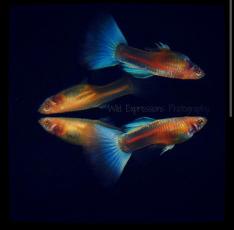
Tank minimum: 5 gallon
Water parameters: 64-82° F, KH 10-30, pH 6.5-8.0 GH 90-536ppm
Maximum size: 2″
Tank region: Top, Mid-dwelling
Behavior: Peaceful
Diet: Will accept most foods that include a high quality flake or crushed pellet. There are foods formulated specifically for guppies that are small enough pellets for them to eat.
Compatibility: Quite community tank. Avoid fin nippers or overly boisterous tankmates.
Extra: Guppies are a fun little fish that are a common choice for beginners. They are highly adaptable but should not be kept in softer water. Slightly brackish water and avoiding a strong current is ideal for guppies. While they can survive without a filter, it is still recommended to have one. It also isn’t necessary to keep a heater if you live in an area with mild conditions. However, if your home drops more than 4 degrees at night, it is recommended to keep a heater to avoid the temperatures dropping too drastically.
HatchetFish
Marble Hatchetfish
Silver Hatchetfish
Marble Hatchet
(Carnegiella strigata)

Difficulty: 2/5
Tank minimum: 10 gallons
Water parameters: 75-81° F, KH 10-18, pH 5.5-7.5
Maximum size: 1.5″
Tank region: Top-dwelling
Behavior: Peaceful and active schooling fish. Groups of 6 or more is ideal.
Diet: Will accept most foods. Primarily a carnivore, they should have mosquito larvae, brine shrimp, etc. in their diet.
Compatibility: Best suited with other peaceful, community fish. Avoid other top dwelling fish that could compete for space.
Extra: Hatchetfish have powerful pectoral fins that give them the ability to propel themselves a few yards out of water. Because of this, it’s very important that your aquarium has a secure lid when housing these fish. Plenty of decorations, particularly a floating plant is ideal for keeping this fish happy and avoid spooking. They can be sensitive to water conditions, so it is vital to keep their water exceptionally clean and well oxygenated.
Silver Hatchet
(Gasteropelecus sternicla)

Difficulty: 2/5
Tank minimum: 10 gallons
Water parameters: 75-81° F, KH 10-18, pH 5.5-7.5
Maximum size: 1.5″
Tank region: Top-dwelling
Behavior: Peaceful and active schooling fish. Groups of 6 or more is ideal.
Diet: Will accept most foods. Primarily a carnivore, they should have mosquito larvae, brine shrimp, etc. in their diet.
Compatibility: Best suited with other peaceful, community fish. Avoid other top dwelling fish that could compete for space.
Extra: Hatchetfish have powerful pectoral fins that give them the ability to propel themselves a few yards out of water. Because of this, it’s very important that your aquarium has a secure lid when housing these fish. Plenty of decorations, particularly a floating plant is ideal for keeping this fish happy and avoid spooking. They can be sensitive to water conditions, so it is vital to keep their water exceptionally clean and well oxygenated.
Killifish
Golden Wonder Killifish
Golden Wonder Killifish
(Apolcheilus lineatus)

Difficulty: 2/5
Tank minimum: 20 gallons
Water parameters: 72-75° F, KH 3-8, pH 6.0-7.5
Maximum size: 4″
Tank region: Top-dwelling
Behavior: Peaceful, community. Can be in groups or pairs.
Diet: Meaty foods such as live bloodworms, black worms, tubifex. High quality flake, pellet, and frozen foods.
Compatibility: Can be housed with other community fish, though not recommended with smaller fish that may fit in it’s mouth.
Extra: These fish are great choices for beginners. However, they require a secure lid as they are excellent jumpers and they also are known for eating smaller fish and invertebrates. For this reason, I have given them a 2/5 in difficulty. They are still easy keepers and prefer a heavily decorated tank, preferably with live plant.
Loach
Dojo Loach
Kuhlii Loach
Reticulated Hillstream Loach
Dojo Loach
(Misgurnus anguillicaudatus)

Difficulty: 1/5
Tank minimum: 20 gallon for juvenile, 50 gallon larger
Water parameters: 50-82° F, KH 3-5, pH 6.5-8.0
Maximum size: 10″
Tank region: Bottom dwelling
Behavior: Peaceful
Diet: Accepts good quality flake, sinking pellets, thawed frozen Bloodworm, Mysis Shrimp, Brine Shrimp, Earthworm, and will avidly eat snails, etc.
Compatibility: Peaceful/Community. Snails and invertebrates are not suitable tankmates.
Extra: This unique fish is said to be able to predict the weather giving them the nickname “weather loach.” It is believed they are responding to the barometric pressure and will swim wildly about when a storm is approaching. They are a great beginner choice and one of the more popular loaches due to their hardy nature. While adaptable to many conditions, they prefer cooler temperatures as the higher temperatures tend to stress them out and make them more susceptible to disease. Avoid substrates with sharp edging that can injure the loach’s belly. They do well in a planted aquarium, but larger specimens may uproot plants in their search for food. This should have a secure top as the fish are great escape artists.
Kuhlii Loach
(Pangio sp.)
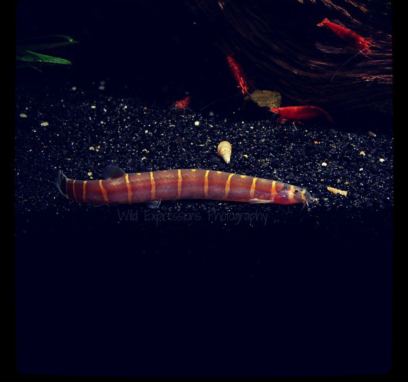
Difficulty: 3/5
Tank minimum: 15 gallon
Water parameters: 79-86° F, KH 3-5, pH 6.0-6.5
Maximum size: 4″
Tank region: Bottom dwelling
Behavior: Peaceful, shoaling. Groups of 6 or more is ideal
Diet:
Compatibility: Peaceful community. Avoid keeping with larger and/or more aggressive fish such as cichlid.
Extra: These bottom dwellers can be an interesting addition. However, their care can be a tad tricky which is why I have rated them a 3/5. First, it is a necessity to have a soft substrate such as a fine grain sand. Kuhli loach like to burrow in the sand, and if the substrate is too sharp they can be injured. A lot of hiding areas and darker spots are ideal options for this fish. Like all loach, these fish are scaleless and can be sensitive to medications, especially containing copper which can be fatal.
Reticulated Hillstream Loach
(Sewellia lineolata)

Difficulty: 3/5
Tank minimum: 30 gallon
Water parameters: 64-75° F, KH 10-15, pH 6.0-7.5, GH 18-179ppm
Maximum size: 3″
Tank region: Bottom and around the sides
Behavior: Peaceful
Diet: Ideally algae covered rocks, but algae wafers, sinking wafers, and high quality pellet can be substituted. Will occasionally eat live or frozen foods such as brine shrimp, bloodworms, and blackworms
Compatibility: Suitable with community fish that can tolerate cooler waters.
Extra: This interesting little fish can be a tricky addition to your every day aquarium. It requires cooler temperatures in order to thrive and a tank that has a high current. For this reason, this fish may not be a suitable choice for a community tank with a temperature higher than 75 degrees as it’s lifespan will be greatly shortened. It it best suited to a species only or biotope-type aquarium. A powerhead to create fast flowing, highly oxygenated water is ideal, and pristine water conditions are a necessity. Like most loaches, this fish is sensitive to medications.
Minnow
White Cloud Minnow
White Cloud
(Tanichthys albonubes)

Difficulty: 1/5
Tank minimum: 10 gallon
Water parameters: 64-72° F, KH 10-15, pH 6.5-7.5
Maximum size: 1.5″
Tank region: Top, Mid-dwelling
Behavior: Peaceful, schooling groups 6+ ideal
Diet: Includes almost all food choices and will do best on a high quality pellet or flake
Compatibility: Other similar sized, peaceful/community fish
Extra: This undemanding little fish is a great choice for beginners. They do best in aquariums with cooler temperatures, but are otherwise very adaptable. They have been used in ponds to help control mosquito populations, though would not be suitable tankmates for larger pond fish as they could be eaten. Avoid medications containing copper as they can be quite sensitive to this.
Molly
Balloon Molly
Black Molly
Dalmation Molly
Lyretail Molly
Sailfin Molly
Balloon Molly
(Poecilia sp)

Difficulty: 2/5
Tank minimum: 10 gallons
Water parameters: 68-82° F, KH 10-25, pH 7.0-7.8
Maximum size: 3″
Tank region: Top-Mid dwelling
Behavior: Peaceful
Diet: Will accept most foods that should include a high quality flake or pellet.
Compatibility: Peaceful/Community, shoaling and enjoys the company of same species fish.
Extra: Like other mollies, balloon mollies can slowly adapt to either freshwater or saltwater aquariums. In a freshwater aquarium a teaspoon of aquarium salt per gallon will keep the molly in optimum health. Unlike other mollies, the balloon molly is has a rounded appearance created by a defect. Due to this defect, balloon mollies are more prone to health issues and tend to not be quite as hardy as other mollies. But just like other mollies, they are livebearers and prolific breeders and can give birth up 6 months without a male.
Black Molly
(Poecilia latipinna)

Difficulty: 1/5
Tank minimum: 10 gallons
Water parameters: 68-82° F, KH 10-25, pH 7.0-7.8
Maximum size: 3″
Tank region: Top to Mid Dwelling
Behavior: Peaceful
Diet: Will accept most foods that should include a high quality flake or pellet.
Compatibility: Peaceful/Community, shoaling and enjoys the company of same species fish.
Extra: Like other mollies, black mollies can slowly adapt to either freshwater or saltwater aquariums. In a freshwater aquarium a teaspoon of aquarium salt per gallon will keep the molly in optimum health. They are livebearers and prolific breeders and can give birth up 6 months without a male.
Dalmatian Molly
(Poecilia latipinna)
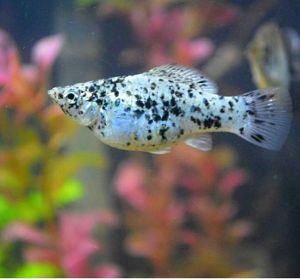
Difficulty: 1/5
Tank minimum: 20 gallon
Water parameters: 68-82° F, KH 10-25, pH 7.0-7.8
Maximum size: 5″
Tank region: Top to Mid-dwelling
Behavior: Peaceful
Diet: Will accept most foods that should include a high quality flake or pellet.
Compatibility: Peaceful/Community, shoaling and enjoys the company of same species fish.
Extra: Like other mollies, dalmation mollies can slowly adapt to either freshwater or saltwater aquariums. In a freshwater aquarium a teaspoon of aquarium salt per gallon will keep the molly in optimum health. They are livebearers and prolific breeders and can give birth up 6 months without a male.
Lyretail Molly
(Poecilia latipinna)

Difficulty: 1/5
Tank minimum: 20 gallon
Water parameters: 68-82° F, KH 10-25, pH 7.0-7.8
Maximum size: 5″
Tank region: Top to Mid-dwelling
Behavior: Peaceful
Diet: Will accept most foods that should include a high quality flake or pellet.
Compatibility: Peaceful/Community, shoaling and enjoys the company of same species fish.
Extra: Like other mollies, black mollies can slowly adapt to either freshwater or saltwater aquariums. In a freshwater aquarium a teaspoon of aquarium salt per gallon will keep the molly in optimum health. They are livebearers and prolific breeders and can give birth up 6 months without a male.
Sailfin Molly
(Poecilia latipinna)

Difficulty: 1/5
Tank minimum: 20 gallon
Water parameters: 68-82° F, KH 10-25, pH 7.0-7.8
Maximum size: 6.5″
Tank region: Top to Mid-dwelling
Behavior: Peaceful
Diet: Will accept most foods that should include a high quality flake or pellet.
Compatibility: Peaceful/Community, shoaling and enjoys the company of same species fish.
Extra: Like other mollies, sailfin mollies can slowly adapt to either freshwater or saltwater aquariums. In a freshwater aquarium a teaspoon of aquarium salt per gallon will keep the molly in optimum health. They are livebearers and prolific breeders and can give birth up 6 months without a male.
Peacock Gudgeon
(Tateurndina ocellicauda)


←Back
Difficulty: 1/5
Tank minimum: 10 gallon
Water parameters: 72-77° F, KH 5-12, pH 7.0-7.8, GH to not exceed 80ppm
Maximum size: 3″
Tank region: Lower dwelling
Behavior: Peaceful
Diet: Will accept most foods that should include a high quality flake or pellet.
Compatibility: Other similar sized, peaceful fish. Can be kept with dwarf cichlids if suitable size tanks
Extra: This stunning little fish is a great addition for both beginners and advance keepers alike. It’s easy requirements make it a great choice for beginners, while it’s striking colors can still keep the interest of more advanced keepers. Peacock gudgeons can be kept in small groups without issue. Males may display and flare to one another, but is rarely an actual fight. This behavior can actually be quite entertaining and make for an interesting tank.
Pencilfish
(Nannostomus sp.)

Difficulty: 2/5
Tank minimum: 10 gallons
Water parameters: 72-83° F, KH 2-5, pH 5.5-7.0
Maximum size: 2″
Tank region: Top to Mid-dwelling
Behavior: Peaceful, schooling
Diet: Will accept most foods that nclude a high quality flake or pellet. Live or frozen foods such as daphnia, tubifex, baby brine shrimp will help bring out their color.
Compatibility: Peaceful/Community, ideally without overly boisterous tankmates. Ideal dither fish for dwarf cichlid.
Extra: This little fish is a great addition to most community tanks. They can be sensitive to nitrates so it is important to keep water in optimum condition and why they are given 2/5 . This schooling fish should be kept in groups in at least 6 or more to ensure that aggression is spread out among individuals.
Platy


←Back
Difficulty: 1/5
Tank minimum: 10 gallon, 5 gallon for single platy
Water parameters: 64-77° F, KH 10-25, pH 7.0-8.2
Maximum size: 2″
Tank region: All over
Behavior: Peaceful
Diet: Will accept most foods that should include a high quality flake or pellet.
Compatibility: Any peaceful/community fish
Extra: This forgiving little fish is a phenomenal choice for beginners. Not only is it easy to care for, a great tank mate for most communities, but it also can add that color that many people desire to have in their tanks. Like mollies, platies are livebearers and are prolific breeders. They can tolerate slightly brackish waters; but unlike the similar looking molly, they cannot be acclimated to saltwater aquariums.
Rainbowfish
Boesemani Rainbow Fish
Dwarf Neon Rainbow Fish
Threadfin Rainbow Fish
Turquoise Rainbow Fish
Boesemani Rainbow
(Melanotaenia boesemani)
Difficulty: 1/5
Tank minimum: 30 gallon long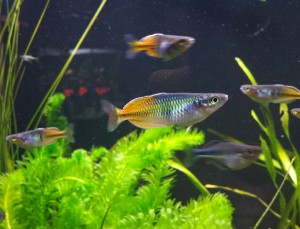
Water parameters: 72-83° F, KH 9-19, pH 7.0-8.0
Maximum size: 4.3″
Tank region: Mid dwelling
Behavior: Peaceful, active, schooling
Diet: Will accept most foods that nclude a high quality flake or pellet. Variety of live or frozen foods such as daphnia, tubifex, krill, brine shrimp will help bring out their color.
Compatibility: Suitable for other similar sized fish that can tolerate the boesemani’s activity level. Should be kept in a group of 6 or more. Can be kept with rift lake cichlid
Extra: This active fish is a perfect choice for those looking for a larger, colorful schooling fish. They’re low requirements make them a great choice for beginners starting a larger tank. Due to their tolerance for a higher ph, they can even be kept with rift cichlids with caution.
Dwarf Neon Rainbow
(Melanotaenia praecox)

Difficulty: 1/5
Tank minimum: 20 gallons
Water parameters: 64-72° F, KH 8-12, pH 5.8-6.5
Maximum size: 3″
Tank region: Mid-dwelling
Behavior: Peaceful, active, schooling
Diet: Will accept most foods that include a high quality flake or pellet. Variety of live or frozen foods such as daphnia, tubifex, krill, brine shrimp will help bring out their color.
Compatibility: Peaceful/Community
Extra: This peaceful schooling fish is a wonderful choice for beginners due to it’s easy care and peaceful nature. Unlike other rainbows, the dwarf neon prefers slightly acidic water.
Threadfin Rainbow
(Iriatherina werneri)

Difficulty: 3/5
Tank minimum: 10 gallons
Water parameters: 72-77° F, KH 7-10, pH 5.8-6.5
Maximum size: 1.5″
Tank region:
Behavior: Peaceful, timid
Diet: Picky, slow eaters. Live foods such as mosquito larvae, microworms, cyclops, rotifers and baby brine shrimp are ideal, but can accept crushed micro pellets and flake.
Compatibility: Other similar sized, peaceful fish. Avoid aggressive eaters
Extra: This shy little fish makes for an interesting addition. They tend to be quite sensitive to unstable water conditions and are prone infection making them an unwise choice for the beginning aquarist and rating them a 3/5. A heavily decorated tank, preferably with live plants, is ideal. A top floating plant may make this timid fish more comfortable and less likely to hide. While not a schooling fish, they do enjoy the company of other threadfins. It is best to do more frequent, smaller water changes instead of larger water changes when keeping this fish.
Turquoise Rainbow
(Melanotaenia lacustris)

Difficulty: 1/5
Tank minimum: 40 gallon long
Water parameters: 70-78° F, KH 10-12, pH 7.0-8.0
Maximum size: 5″
Tank region: Mid dwelling
Diet: Will accept most foods that include a high quality flake or pellet. Variety of live or frozen foods such as daphnia, tubifex, krill, brine shrimp will help bring out their color.
Compatibility: Suitable for other similar sized fish that can tolerate the turquoise’s activity level. Should be kept in a group of 6 or more.
Extra: This active fish is a perfect choice for those looking for a larger, colorful schooling fish. They’re low requirements make them a great choice for beginners starting a larger tank.
back to the top
Rasbora
Harlequin Rasbora
Scissortail Rasbora
←Back
Harlequin Rasbora
(Rasbora heteromorpha)

Difficulty: 1/5
Tank minimum: 10 gallon
Water parameters: 72-82° F, KH 6-10, pH 6.0-7.5
Maximum size: 1.75″
Tank region: Top, Mid dwelling
Behavior: Peaceful, schooling
Diet: Will accept most foods that include a high quality flake or pellet. Variety of live or frozen foods such as daphnia, tubifex, krill, brine shrimp will help bring out their color.
Compatibility: Peaceful/Community
Extra: Also called the “porkchop” rasbora, this beautiful little fish is a great choice for beginners as it is one of the hardiest and highly adaptable rasbora species kept. A heavily decorated tank (live plants preferable) and a school of 6 or more is ideal for the harlequin.
Scissortail Rasbora
(Rasbora trilineata)

Difficulty: 1/5
Tank minimum: 20 gallon
Water parameters: 73-77° F, KH 2-5, pH 6.0-7.0
Maximum size: 3.5″
Tank region: Top, Mid dwelling
Behavior: Peaceful, schooling
Diet: Will accept most foods that include a high quality flake or pellet. Variety of live or frozen foods such as daphnia, tubifex, krill, brine shrimp will help bring out their color.
Compatibility: Other similar sized, peaceful fish.
Extra: This hardy little fish is a great choice for beginners. A heavily decorated tank (live plants preferable) and a school of 6 or more is ideal for the scissortail.
Silver dollar
(Metynnis argenteus)

Difficulty: 1/5
Tank minimum: 55 gallon
Water parameters: 72-83° F, KH 4-8, pH 5.0-7.5
Maximum size: 6″-7″
Tank region: Mid-dwelling
Behavior: Peaceful, schooling fish. Can be skittish
Diet: Primarily herbivore, but will readily accept most foods.
Compatibility: Most larger species of fish. Can be housed with cichlids as a dither/target fish as long as they aren’t overly aggressive.
Extra: I have found that the silver dollar seems to have some of the most inconsistent information regarding it’s care. I have personally kept many types of fish in my home aquariums, this being one of them I’ve had the longest. Here is my experience;

While many sites say this fish is suitable for a 30 gallon tank, I believe this is grossly inaccurate. Relative to the pacu, the silver dollar reaches around 6″ sometimes larger. This is a large, robust 6″ as this fish is essentially a disk. This fish is also extremely skittish, which is increased if they are not kept in a minimum of 6. I had a group of 8 silver dollar in a 6 ft tank and I couldn’t imagine having any less due to their size and jumpy nature. As they get larger, they become powerful enough to knock decorations down and tend to injure themselves fairly easily. A 55 gallon minimum is a must, though larger is always better.
One thing the silver dollar is great for is a great target/dither fish for south american cichlids or for a school in a predator fish tank. Due to their round shape, even at 6″ it makes them a difficult fish to swallow unless it’s an extremely large predator fish. They are a very hardy fish and can take a hit from an angry cichlid on occasion. A school of dither/target fish has been known to ease the tension in a cichlid tank, and these guys definitely fit the bill for a suitable choice. I have kept them with arowana and other jumpy fish and found silver dollar to be an unwise choice since their spooky nature tends to enable one another. Every individual will have a different experience though.
Sucker catfish
Otocinclus
Pleco
Siamese Algae Eater
Otocinclus
(Otocinclus vittatus)
Difficulty: 2/5
Tank minimum: 20 gallon
Water parameters: 74-79° F, KH 6-10, pH 6.8-7.5
Maximum size: 2″
Tank region: All over, on sides and on decorations
Behavior: Peaceful, shoaling
Diet: Ideally algae covered rocks, but algae wafers, sinking wafers, and high quality pellet can be substituted.
Compatibility: Peaceful/Community
Extra: This dwarf suckerfish is a hard worker when it comes to algae. They are a great choice when keeping planted tanks and they will tirelessly eat the algae. While a relatively easy fish to care for, they can be sensitive to water parameters and should be acclimated slowly as well as avoided while a tank is still becoming established. For this reason, I have given them a 2/5. Like most catfish, be careful when adding medications to your tank as they can be sensitive.
Plecostomus
Common Pleco
(Hypostomus plecostomus)

Difficulty: 1/5
Tank minimum: 55 gallon
Water parameters: 68-85° F, pH 6.0-8.0
Maximum size: 24″
Tank region: All over, most found on sides of glass
Behavior: Peaceful, though can be territorial with same species
Diet: Algae based diet. Algae wafers, veggies such as cucumber, zucchini, etc.
Compatibility: Most species, though can be conspecific aggressive.
Extra: While the common pleco is a well known fish, many people do not know much about it. The common pleco in the fish stores are typically around 1″-3″and many do not realize that this little fish will grow up to be almost 2 feet long! It is also believed by many that this is a good “cleaner” fish when in reality the pleco is actually quite messy. They may help clean the glass of algae, but with that comes a huge bioload, or fish poop. Your glass may be cleaner, but your substrate usually has a lot more filth instead. The larger pleco also tend to get lazier with age and aren’t as great of cleaners it seems.
While a 55 gallon should be fine, a 75 gallon is more adequate when housing this giant beasts. Yes these are giants, and they grow fast as well. Popular to belief, fish do not grow to their tank size. These giants will either continue to outgrow your tank or their growth and lifespan will be greatly stunted. Stunted growth will occur when the fish continues to grow internally, but externally it isn’t able to do so due to it’s tanksize. This usually results in deformations and/or death.
Many fish stores will not take back such a large fish, so unless you have the proper tank size or have a fish store that would be willing to take back your behemoth, I would recommend choosing a smaller species of pleco especially if you have a planted tank as they can be quite destructive. Like most catfish, be careful when adding medications to your tank as they can be sensitive.
Bristlenose Pleco
(Ancistrus sp)


Difficulty: 1/5
Tank minimum: 30 gallons
Water parameters: 72 – 84 F, PH 5.5 – 8.0, GH 5 – 25
Maximum size: 6″
Tank region: All over, most found on sides of glass
Behavior: Peaceful, though males can be territorial
Diet: Algae based diet. Algae wafers, veggies such as cucumber, zucchini, etc.
Compatibility: Most species, though can be conspecific aggressive.
Extra: The bushynose pleco is a great alternative to the common pleco as it stays at much smaller and manageable size. The BN pleco also seems to be a better option for planted tanks, as they are less likely to destroy them. Still use caution when housing a BN pleco in a planted tank though. Like most catfish, be careful when adding medications to your tank as they can be sensitive.
Siamese Algae Eater
(Crossocheilus siamensis)

Difficulty: 1/5
Tank minimum: 30 gallon
Water parameters: 75-79° F, KH 5-10, pH 6.5-7.0
Maximum size: 6″
Tank region: Bottom dwelling, rests on plants and decorations
Behavior: Peaceful, shoaling
Diet: Not a picky eater. Will eat algae off plants, but will except most foods and sinking wafers. Keep veggies in the diet to ensure they don’t snack on plants.
Compatibility: Peaceful/community
Extra: Also know as the flying fox, these fish make a great choice for beginners. True flying fox are considered a peaceful species, though use caution when housing with long finned fish. A with other of the same species, densely planted tank, and oxygen rich waters are ideal.
Swordtail
(Xiphophorus helleri)

Difficulty: 1/5
Tank minimum: 20 gallon
Water parameters: 64-82° F, KH 12-30, pH 7.0-8.3
Maximum size: 5″
Tank region: All over
Behavior: Peaceful
Diet: Will accept most foods that include a high quality flake or pellet. Spirulina algae and brine should be included into their diet to enhance their color.
Compatibility: Peaceful/Community, can defend themselves against larger fish as long as they aren’t big enough to eat them.
Extra: The swordtail is a great option for beginners as it’s hardy, colorful, and quite active. They can be kept in a 10 gallon tank, but wouldn’t recommend keeping more than one male in anything less than a 20 gallon. Swordtails are livebearers and are prolific breeders. They can also be kept in brackish conditions and will thrive.
Tetra
Black Neon Tetra
Black Skirt Tetra
Bleeding Heart Tetra
Cardinal Tetra
Glowlight Tetra
Neon Tetra
Penguin Tetra
Red Eye Tetra
Rummynose Tetra
Serpae Tetra
Silvertip Tetra
Black Neon Tetra
(Hyphessobrycon herbertaxelrodi)

Difficulty: 1/5
Tank minimum: 10 gallon
Water parameters: 72-77° F, KH 4-8, pH 5.5-7.0
Maximum size: 1.5″
Tank region: Top, Mid-dwelling
Behavior: Peaceful, schooling
Diet: Will accept most foods that include a high quality flake or pellet. Variety of live or frozen foods such as daphnia, tubifex, krill, brine shrimp will help bring out their color.
Compatibility: Peaceful/community
Extra: This schooling fish is a great choice for beginners. It’s recommended to keep them in a group of at least 6 or more.
Black Skirt Tetra
(Gymnocorymbus sp.)


Difficulty: 1/5
Tank minimum: 10 gallon
Water parameters: 68-80° F, KH 4-8, pH 6.0-7.5
Maximum size: 2.5″
Tank region: Mid-dwelling
Behavior: Peaceful, schooling
Diet: Will accept most foods that include a high quality flake or pellet. Variety of live or frozen foods such as daphnia, tubifex, krill, brine shrimp will help bring out their color.
Compatibility: Peaceful/Community, caution with long fin and slow moving fish
Extra: This schooling fish is a great choice for beginners. They are a peaceful fish, use caution with keeping with fish with long fins as they can have been known to occasionally nip fins. It’s recommended to keep them in a group of at least 4 or more.
Bleeding Heart Tetra
(Hyphessobrycon erythrostigma)

Difficulty: 1/5
Tank minimum: 10 gallon
Water parameters: 72-77° F, KH 4-8, pH 6.0-6.5
Maximum size: 2″
Tank region: Mid-dwelling
Behavior: Peaceful, school
Diet: Will accept most foods that include a high quality flake or pellet. Variety of live or frozen foods such as daphnia, tubifex, krill, brine shrimp will help bring out their color.
Compatibility: Peaceful/Community
Extra: This schooling fish is a great choice for beginners. It’s recommended to keep them in a group of at least 6 or more.
Cardinal Tetra
(Paracheirodon axelrodi)

Difficulty: 2/5
Tank minimum: 10 gallon
Water parameters: 73-81° F, KH 2-6, pH 5.0-7.5, GH 3-4
Maximum size: 2″
Tank region: All over
Behavior: Peaceful, schooling
Diet: Will accept most foods that include a high quality flake or pellet. Variety of live or frozen foods such as daphnia, tubifex, krill, brine shrimp will help bring out their color.
Compatibility: Other similar sized, peaceful fish.
Extra: Not to be confused with the smaller neon tetra, the cardinal can be a little more difficult to care for. It can be distinguished between the neon by looking at the red coloration on it’s belly. The cardinal’s red will cover the entire bottom portion from nose to tail, while the neon’s red will only cover half of the portion belly to tail. The cardinal tetra can be more sensitive to water parameters as well. While they were mostly wild caught, some captive bred have started to appear in local fish stores. These captive bred will be hardier and more forgiving; however, they can still be tricky to care for. A PH of 5-5.5 and softer water of 3-4 dGH are essential to their care for this reason. It’s also highly recommended to have a heavily decorated tank (preferably with live plants) and a dimmer lighting.
Glowlight Tetra
(Hemigrammus erythrozonus)
Difficulty: 1/5
Tank minimum: 10 gallon
Water parameters: 72-77° F, KH 4-8, pH 5.5-7.0
Maximum size: 2″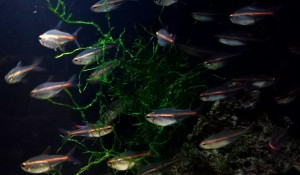
Tank region: All over
Behavior: Peaceful, schooling
Diet: Will accept most foods that include a high quality flake or pellet. Variety of live or frozen foods such as daphnia, tubifex, krill, brine shrimp will help bring out their color.
Compatibility: Peaceful/community. Avoid overly active tankmates or larger tankmates that can eat them.
Extra: This schooling fish is a great choice for beginners. It’s recommended to keep them in a group of at least 6 or more. Although they are a schooling fish, they don’t school up quite as much when comfortable. Avoid overly active tankmates as they can stress out the glowlight.
Neon Tetra
(Paracheirodon innesi)

Difficulty: 1/5
Tank minimum: 10 gallon
Water parameters: 68-74° F, KH 4-8, pH 5.0-7.0
Maximum size: 1.5″
Tank region: All over
Behavior: Peaceful, schooling
Diet: Will accept most foods that include a high quality flake or pellet. Variety of live or frozen foods such as daphnia, tubifex, krill, brine shrimp will help bring out their color.
Compatibility: Other similar sized, peaceful fish.
Extra: Not to be confused with the larger cardinal tetra, the neon tetra is a great option for beginners. It can be distinguished between the cardinal by looking at the red coloration on it’s belly. The cardinal’s red will cover the entire bottom portion from nose to tail, while the neon’s red will only cover half of the portion belly to tail. Though the neon is still a great beginner fish, it’s important to keep up with regular water changes and they can be sensitive to poor water quality and nitrates. While they are usually very low cost, they may not be a good choice when using a tank to cycle as they aren’t as hardy.
Penguin Tetra
(Thayeria boehlkei)
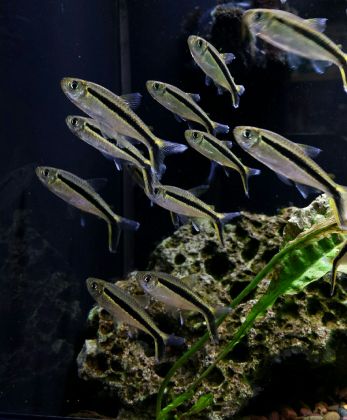
Difficulty: 1/5
Tank minimum: 30 gallons
Water parameters: 64-82° F, KH 4-8, pH 5.8-8.5
Maximum size: 3.2″
Tank region: Top, Mid-dwelling
Behavior: Peaceful, schooling
Diet: Will accept most foods that include a high quality flake or pellet. Variety of live or frozen foods such as daphnia, tubifex, krill, brine shrimp will help bring out their color.
Compatibility: Community, suitable with dwarf cichlids and anabantoids
Extra: This schooling fish is a great choice for beginners. They are a peaceful fish, though avoid keeping with fish with long fins as they can be fin nippers. It’s recommended to keep them in a group of at least 6 or more to evenly distribute aggression amongst themselves. Ideally 10 or more if possible and the tank is large enough. A heavily planted tank and a dimmer light is preferred by this species.
Red Eye Tetra
(Moenkhausia sanctaefilomene)
Difficulty: 1/5
Tank minimum: 20 gallon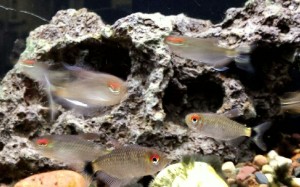
Water parameters: 72-82° F, KH 4-8, pH 5.8-8.5
Maximum size: 3″
Tank region: Mid-dwelling
Behavior: Peaceful, schooling
Diet: Will accept most foods that include a high quality flake or pellet. Variety of live or frozen foods such as daphnia, tubifex, krill, brine shrimp will help bring out their color.
Compatibility: Peaceful/Community, use caution long fin or slow moving tankmates
Extra: This schooling fish is a great choice for beginners. They are a peaceful fish, use caution with keeping with fish with long fins as they can have been known to occasionally nip fins. It’s recommended to keep them in a group of at least 6 or more. They are an active schooling fish that will dominate the mid portion of your tank, so they may disturb less active top to mid-dwelling fish.
Rummynose Tetra
(Hemigrammus bleheri)

Difficulty: 1/5
Tank minimum: 10 gallon
Water parameters: 72-77° F, KH 2-6, pH 5.5-7.0
Maximum size: 2″
Tank region: Mid-dwelling
Behavior: Peaceful, schooling
Diet: Will accept most foods that include a high quality flake or pellet. Variety of live or frozen foods such as daphnia, tubifex, krill, brine shrimp will help bring out their color.
Compatibility: Peaceful/community. suitable with dwarf cichlids and anabantoids.
Extra: This schooling fish is a great choice for beginners. They are a peaceful fish, use caution with keeping with fish with long fins as they can have been known to occasionally nip fins. It’s recommended to keep them in a group of at least 6 or more, though ideally 10 or more is better but tank size should be accommodated.
Serpae Tetra
(Hyphessobrycon callistus)
Difficulty: 1/5
Tank minimum: 10 gallon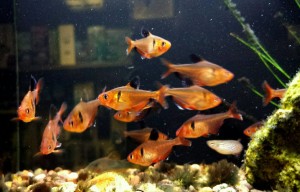
Water parameters: 72-82° F, KH 4-8, pH 6.0-7.5
Maximum size: 1.75″
Tank region: Mid-dwelling
Behavior: Peaceful, schooling
Diet: Will accept most foods that include a high quality flake or pellet. Variety of live or frozen foods such as daphnia, tubifex, krill, brine shrimp will help bring out their color.
Compatibility: Peaceful/community, some semi-aggressive, avoid fish with long flowing fins and timid eaters
Extra: This schooling fish is a great choice for beginners. They are a peaceful fish, though avoid keeping with fish with long fins as they can be fin nippers. It’s recommended to keep them in a group of at least 6 or more to evenly distribute aggression amongst themselves.
Silver Tip Tetra
(Hasemania nana)
Difficulty: 1/5
Tank minimum: 10 gallon
Water parameters: 64-82° F, KH 4-8, pH 5.8-8.5
Maximum size: 2″
Tank region: Mid-dwelling
Behavior: Peaceful, schooling
Diet: Will accept most foods that include a high quality flake or pellet. Variety of live or frozen foods such as daphnia, tubifex, krill, brine shrimp will help bring out their color.
Compatibility: Peaceful/community
Extra: This schooling fish is a great choice for beginners. They are a peaceful fish, use caution with keeping with fish with long fins as they can have been known to occasionally nip fins. It’s recommended to keep them in a group of at least 6 or more, though a tank of 20 gallons should be used to accommodate them.

Leave a comment